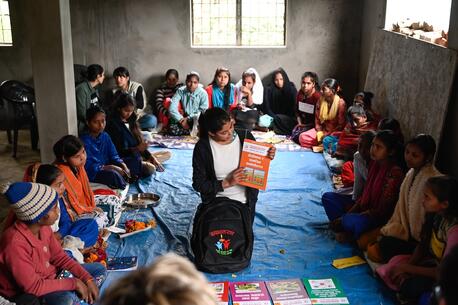Innovation from the ground up
Sean Blaschke is a Technology for Development Specialist at UNICEF in Uganda, who recently held a discussion about Uganda's Innovation Lab. The challenge, he said, was not coming up with great ideas for using technology to further UNICEF's development goals. The challenge was in understanding the systems involved in implementing an idea, getting buy-in from staff members, working with country standards and protocols, and aligning with the government's longer-term strategic plan.
Joyce Chen is a Project Lead at Jump Associates, a growth strategy firm with offices in San Mateo, California and New York City. Jump is collaborating with UNICEF and the U.S. Fund on the HIV/AIDS Innovation Fund.
"Technology is the easy part. Getting the program right is the hard part."
 So posited Sean Blaschke, a Technology for Development Specialist at UNICEF in Uganda, at a recent presentation and discussion about Uganda's Innovation Lab. The challenge, he said, was not coming up with great ideas for using technology to further UNICEF's development goals. The challenge was in nderstanding the systems involved in implementing an idea, getting buy-in from staff members, working with country standards and protocols, and aligning with the government's longer-term strategic plan.
We had heard this refrain repeated many times by various stakeholders in Jump's recent collaboration with the U.S. Fund and UNICEF HQ to define their HIV/AIDS Innovation Fund strategy. For this reason, we were excited to host UNICEF, U.S. Fund, and its corporate partners for this eventso that we could learn more about how innovation happens on the ground and meet some of the folks leading the charge at UNICEF.
Sean shared a couple examples of innovative projects going on at the Uganda Innovation Lab, including Digital Drums and standalone Information Access Points. Digital Drums are free, public computers with Internet access located in Ugandan villages. The production process employed local welders and ingeniously repurposed used oil drums as part of the hardware in order to keep costs low. Information Access Points are huts powered by solar energy that house several Internet access points and provide a variety of human services for community members.
Initiatives like these succeed because they accomplish a few key things:
So posited Sean Blaschke, a Technology for Development Specialist at UNICEF in Uganda, at a recent presentation and discussion about Uganda's Innovation Lab. The challenge, he said, was not coming up with great ideas for using technology to further UNICEF's development goals. The challenge was in nderstanding the systems involved in implementing an idea, getting buy-in from staff members, working with country standards and protocols, and aligning with the government's longer-term strategic plan.
We had heard this refrain repeated many times by various stakeholders in Jump's recent collaboration with the U.S. Fund and UNICEF HQ to define their HIV/AIDS Innovation Fund strategy. For this reason, we were excited to host UNICEF, U.S. Fund, and its corporate partners for this eventso that we could learn more about how innovation happens on the ground and meet some of the folks leading the charge at UNICEF.
Sean shared a couple examples of innovative projects going on at the Uganda Innovation Lab, including Digital Drums and standalone Information Access Points. Digital Drums are free, public computers with Internet access located in Ugandan villages. The production process employed local welders and ingeniously repurposed used oil drums as part of the hardware in order to keep costs low. Information Access Points are huts powered by solar energy that house several Internet access points and provide a variety of human services for community members.
Initiatives like these succeed because they accomplish a few key things:

Some innovative projects at the UNICEF Uganda Innovation Lab
- They design for scale. Prototypes take into account the systems that need to be in place to replicate the concept in a different place.
- They strengthen government systems. The Information Access huts, for example, double as locations where government health ministries can provide services.
- They invest in local capacity. They employ local workers as well as local materials.
- They keep it simple. They focus on creating useful tools instead of reinventing the wheel.
- They focus on the user experience. First and foremost, they create value for the community. Technology's ability to gather data about constituents is a secondary benefit for UNICEF.

